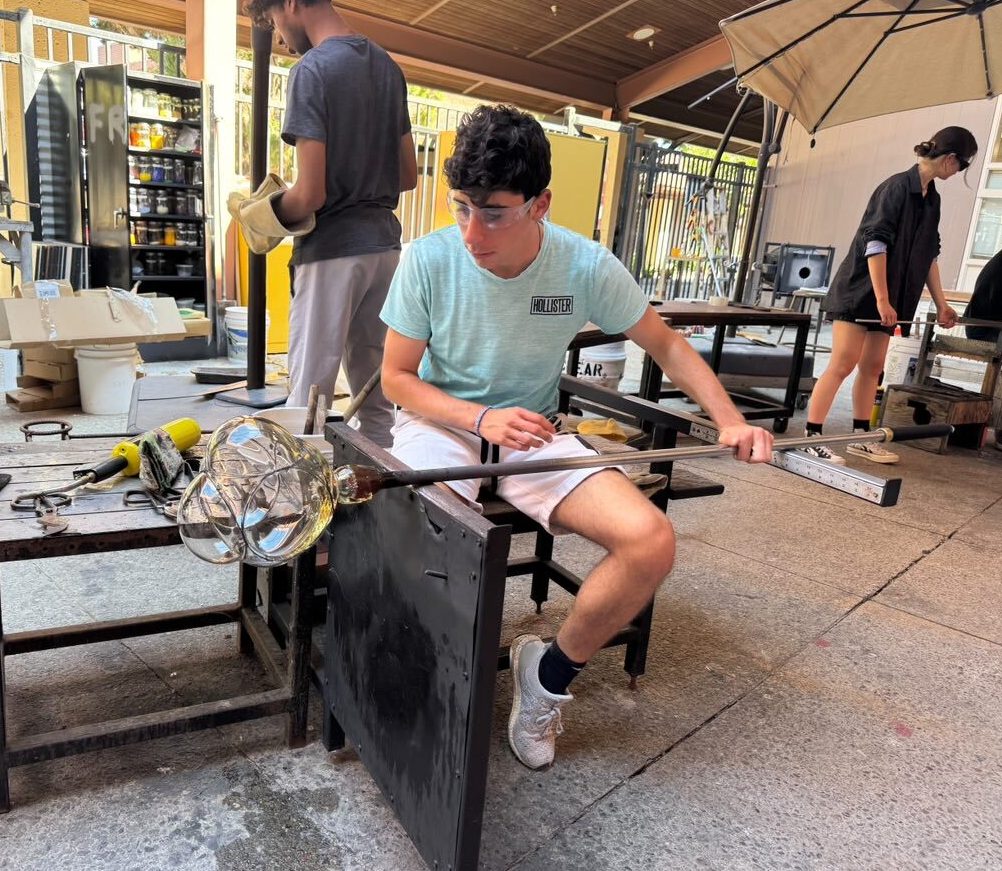As glassblowing teacher Mike da Ponte effortlessly spins the punti, maintaining the perfect balance at the centerpoint of the molten glass blob at the end of the metal rod, the sunlight reflects into the hot shop, shimmering on the glass’ red-hot surface. Sculpting the glass into a beautifully symmetric cup, da Ponte maneuvers around the glass studio, eventually plunging the cup into the furnace as the heat envelops the glass in a fiery blaze.
Launched by former art teacher David Camner nearly 25 years ago, the Paly glassblowing program has nurtured students to love working with glass. From large vessels made in the outdoor furnace to glass beads made with desktop torches, students in the 3D Art pathway learn to use glass as a form of artistic expression.
Da Ponte, hired this summer to expand the glassblowing program, comes to Paly after 12 years starting and running a glassworking studio at New Trier High School outside of Chicago, one of the only other high schools in the country to have a hot shop.
Da Ponte said he encourages students to take advantage of the versatility of glass by combining different art techniques and incorporating other mediums, as he does in his own art.
“We are starting to do (mixed media glass) and ceramics already,” da Ponte said. “I just want to offer that for every project we do, building that slowly into the program.”
Principal Brent Kline said he hopes his support and resources can help da Ponte act on his proposed changes to the Fiery Arts program, and Kline looks forward to the inspiration da Ponte’s updated program will bring to more students.
“When you see some of his art and the work that he’s already done, it integrates a lot of different forms, not just glass,” Kline said. “That’s what I’m looking forward to having him bring to our visual arts program: just a different perspective.”
Da Ponte said he has high hopes for the future of the program. He said there has been discussion within the art department of separating Art Spectrum into two classes, specified for 2D or 3D art, while still following the general Art Spectrum guidelines.
“It’s nice to be able to choose whether it’s 2D or 3D at the beginning, so kids can navigate different materials at the start,” da Ponte said.
Brittney Kerby, Instructional Lead for the arts department, said the department redesigned what they were envisioning for the visual arts pathway by separating Art Spectrum into two classes.
“It’s going to be great and it honors what students want to do, so it’s going to better serve the students’ interest,” Kerby said. “I’m hoping to see students excited about the different kinds of art that we offer here – we do have an incredible 3D program.”
Da Ponte said he is also hoping to update the hot shop equipment and add a third furnace because he said much of the current equipment is outdated and doesn’t provide the latest safety standards and efficiencies.
“Another part of that is energy efficiency,” da Ponte said. “I think that’s a really good shift towards being a more efficient studio and abiding by a better environmental footprint.”
In the long-term, da Ponte said he hopes to bring more glass techniques and processes to the program in addition to the hot shop, including casting, fusing, slumping, mosaics and flameworking.
“The hot shop only draws a small percentage of kids to actually work in there, so I think offering more techniques is a more inclusive way to build a better 3D program,” da Ponte said. “I’m hoping I can make this program better, and I hope that we can get more kids who are interested in glass.”
Currently, students can only participate in glassblowing after taking Art Spectrum, a year-long course, and then enrolling in Ceramics and Sculpture. However, the Fiery Arts Club which meets on Tuesdays, run by seniors and co-presidents Sophia Kelly and Brian Barrett, tries to make glassblowing accessible to the entire student body.
“It would be really cool if they got an individual glass class,” Kelly said. “I wish I had that when I was going through it.”
Sophomore Angela Fang, who joined the Fiery Arts Club last year and is now taking Ceramics and Sculpture, said the freedom of glassblowing immediately attracted her.
“My favorite part about glassblowing is that you can create so many things in 3D,” Fang said. “I really like how the glass moves — it’s just a really unique type of art medium.”
Overall, Kline said the glassblowing program is a special opportunity all students can take advantage of to learn about glass and experience the artistic process.
“Art is a great way to teach people different skills in a whole different way,” Kline said. “It’s not a textbook thing. It’s not a memorization thing. It’s not a report thing. It’s creating something that’s from your own heart and soul.”


